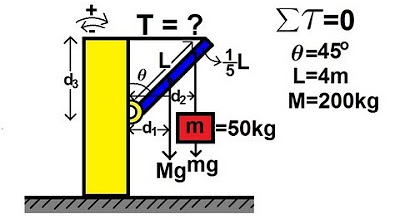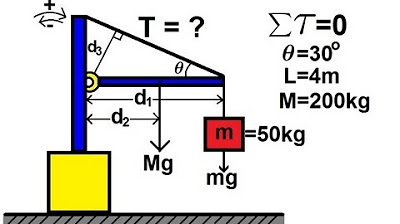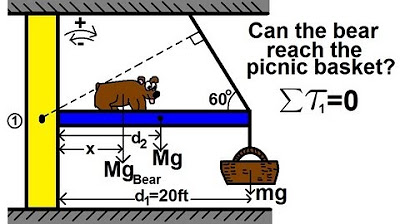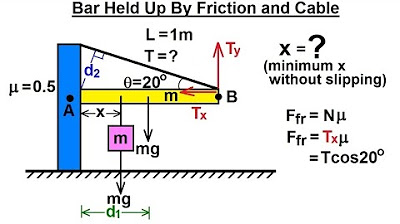Physics 15 Torque Example 3 (3 of 7) Mass on Rod and Cable
TLDRThe video script presents a detailed physics problem involving torque, specifically focusing on finding the tension in a cable attached to a beam. The beam is angled at 45 degrees, with a weight hanging from its edge. The lecturer guides viewers through selecting a pivot point, identifying forces acting on the beam, and calculating distances to the pivot point. Using the principle of torque, the problem is solved by setting up an equation where the sum of torques equals zero. The distances (d1, d2, d3) are calculated using trigonometric functions, and the tension in the cable is found by substituting these values into the equation. The final step involves plugging in the given values and solving for the tension, which is presented in a simplified form with appropriate significant figures. The script emphasizes the importance of understanding the concept of torque, the role of pivot points, and the application of trigonometry in solving such problems.
Takeaways
- 📐 The problem involves finding the tension in a cable attached to a beam at a 45-degree angle to the horizontal.
- 🔍 A pivot point is chosen at the end of the beam to analyze the torques acting on the system.
- ⚖️ The sum of all torques around the pivot point must equal zero, according to the principle of moments.
- 📏 Three forces are identified: the weight of the hanging mass (mg), the weight of the beam (big mg), and the tension in the cable.
- 📐 The distances from the pivot point to the line of action for each force are denoted as d1, d2, and d3.
- 📐 d1 is calculated using the cosine of the angle theta1, d2 using half the length of the beam and the cosine of theta1, and d3 using the sine of the angle theta2 (15 degrees).
- 🔢 The torque equation is set up with the direction of torque defined, where clockwise is positive and counterclockwise is negative.
- 🧮 The equation is simplified by canceling out the common factor (L, the length of the beam) from all terms.
- 🔢 The tension in the cable is solved by substituting the values of d1, d2, and d3 into the simplified equation and solving for the tension (T).
- ⚖️ The values for the mass (small m and big M) and gravitational acceleration (G) are used to calculate the tension in the cable.
- 📐 The final answer for the tension is given in Newtons, with consideration for significant figures as per the original information provided.
Q & A
What is the main physics concept being discussed in the transcript?
-The main physics concept being discussed is torque, specifically how to calculate the tension in a cable attached to a beam with a weight hanging from it.
What is the significance of choosing a pivot point in solving torque problems?
-Choosing a pivot point is significant because it is the point around which the torques are calculated. The sum of all torques around this point should equal zero for a system in equilibrium.
How is the direction of torque defined in the transcript?
-In the transcript, a clockwise torque is defined as positive, and a counterclockwise torque is defined as negative. This definition is arbitrary and can vary in different textbooks.
What are the three forces acting on the beam that contribute to the torque?
-The three forces acting on the beam are the weight of the hanging mass (mg), the weight of the beam itself (big mg), and the tension in the cable.
How are the distances from the pivot point to the line of action of the forces represented in the problem?
-The distances are represented as d1, d2, and d3, corresponding to the distances for the weight of the hanging mass, the weight of the beam, and the tension in the cable, respectively.
What trigonometric functions are used to find the values of d1, d2, and d3?
-The values of d1, d2, and d3 are found using the cosine function for angles theta1 and theta2, and the sine function for the angle of 15 degrees (fee).
What is the final formula used to calculate the tension in the cable?
-The final formula used to calculate the tension in the cable is T = (mg*cos(theta1) + big*mg*cos(theta1)) / (sin(fee)), after canceling out the common factor L from each term.
What is the significance of the angle between the beam and the horizontal axis in this problem?
-The angle between the beam and the horizontal axis, which is 45 degrees, is significant because it determines the angles used in the trigonometric calculations for finding d1, d2, and d3.
How does the mass of the hanging weight and the beam affect the tension in the cable?
-The mass of the hanging weight (small mg) and the beam (big mg) directly affect the tension in the cable by contributing to the sum of the torques acting on the system.
What is the final calculated tension in the cable, and how should it be expressed in terms of significant figures?
-The final calculated tension in the cable is 1.9 x 10^5 Newtons, which is expressed with two significant figures to match the precision of the original information provided.
Why is it important to consider the direction of the forces when calculating torques?
-It is important to consider the direction of the forces because the direction determines whether the torque is positive (clockwise) or negative (counterclockwise), which is crucial for the correct summation of torques in the equation.
How does the use of trigonometric functions help in solving this torque problem?
-Trigonometric functions help in solving this torque problem by allowing us to calculate the perpendicular distances (d1, d2, d3) from the pivot point to the line of action of the forces, which are necessary to determine the torques.
Outlines
🔍 Analyzing Torque with a Beam and Cable
The paragraph introduces a physics problem involving a beam at a 45-degree angle with a cable and a hanging weight. The goal is to find the tension in the cable. The solution involves selecting a pivot point at the end of the beam and calculating the torques produced by the weight of the hanging mass, the weight of the beam itself, and the tension in the cable. The torques are calculated based on their respective distances from the pivot point (d1, d2, and d3). The forces considered are the gravitational force on the hanging mass (mg), the weight of the beam (big mg), and the tension force in the cable (T). The principle of torque states that the sum of torques around the pivot point equals zero, which is used to set up the equation and solve for the tension in the cable.
📐 Calculating Distances and Solving for Tension
This paragraph focuses on calculating the distances (d1, d2, d3) from the pivot point to the lines of action of the forces acting on the beam. Using trigonometric relationships, d1 is found to be L times the cosine of theta1, d2 is L/2 times the cosine of theta2, and d3 is L times the sine of the angle between the beam and the horizontal axis (15 degrees). After finding these distances, they are substituted into the torque equation, which is then simplified by canceling out the common factor L. The equation is solved for the tension (T) in the cable, considering the angles and the masses of the objects involved. The tension is calculated using the given values for the masses (small m and big M) and gravitational acceleration (G), with the final result being expressed in Newtons.
🧮 Review of the Torque Problem and Significance of Figures
The final paragraph reviews the steps taken to solve the torque problem and emphasizes the importance of significant figures in the calculation. It reiterates the process of identifying the forces acting on the beam, determining the distances to the pivot point, and summing up the torques to find the unknown tension in the cable. The paragraph also corrects a previous error regarding the angles used in the calculation and shows how to properly plug in the values to solve for the tension. The result is then rounded to reflect the number of significant figures provided in the original information, highlighting the need for precision and accuracy in physics problems.
Mindmap
Keywords
💡Torque
💡Pivot Point
💡Beam
💡Weight
💡Tension
💡Distance
💡Force
💡Rotational Equilibrium
💡Angles
💡Significant Figures
💡Calculator
Highlights
Introduction to an online lecture on torque physics problems.
Dealing with a beam angled at 45 degrees with a cable and weight system to find the tension in the cable.
Choosing a pivot point at the end of the beam for torque calculations.
Summation of torques around the pivot point equals zero to solve for tension.
Identifying three forces acting on the beam: the weight of the hanging mass, the weight of the beam, and the tension in the cable.
Calculating the distance from the pivot point to the line of action for each force to determine torques.
Defining the direction of torque as positive for clockwise and negative for counterclockwise rotation.
Setting up the equation for torques using force times distance, with direction considerations.
Substituting the values of distances (d1, d2, d3) into the torque equation.
Using trigonometric functions to find distances d1, d2, and d3 based on the angles and beam length.
Simplifying the equation by canceling out the common factor (length of the beam, L).
Solving for the tension in the cable by isolating the variable and applying the values of angles.
Calculating the tension with given mass values and gravitational acceleration.
Correcting an error in the equation by aligning the angles for the forces acting on the beam.
Finalizing the calculation by dividing by the sine of the angle between forces.
Arriving at the tension value in Newtons, with a correction for significant figures.
Reviewing the steps taken to solve the torque problem, emphasizing the methodical approach.
Highlighting the practical application of torque principles in physics problem-solving.
Transcripts
Browse More Related Video

Physics 15 Torque Example 2 (2 of 7) Mass on Rod and Cable

Physics 15 Torque Example 1 (1 of 7) Mass on Rod and Cable

Physics 15 Torque (19 of 25) More Examples: 1 T=? of Cable Holding Fish

Physics 15 Torque Example 6 (6 of 7) The Hungry Bear on a Beam; Tension in the Cable

Physics 15 Torque (4 of 27) Bar Held Up by Friction

Physics 15 Torque (3 of 27) Tension=? in the Cable
5.0 / 5 (0 votes)
Thanks for rating: